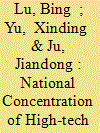| Srl | Item |
| 1 |
ID:
158907


|
|
|
|
|
| Summary/Abstract |
This paper comprehensively reviews China's openness since 1978 from three aspects: trade, foreign investment and global production sharing. We point out that the economic development of China is now standing at a historic turning point. Specifically, economic changes in China are discussed from four dimensions: (i) from China being a world assembly line to a world manufacturing powerhouse; (ii) from China being a world capital receiver to a world investor; (iii) from China being a world factory to a world market; and (iv) from the situation of “made in China” to “innovated in China.” At the same time, the global economic system has also reached a turning point. A “North America–Europe–Asia” tri‐polar system has formed, in which the USA, Germany and China, respectively, serve as the regional core economies.
|
|
|
|
|
|
|
|
|
|
|
|
|
|
|
|
| 2 |
ID:
190398


|
|
|
|
|
| Summary/Abstract |
Based on the product-country level trade data from 2004 to 2017, as well as the High-Tech Products Catalog from the US Census Bureau, this paper examines empirically the current phenomenon of “national concentration” in high-tech exports. The results show that the phenomenon of “national concentration” not only exists but also tends to be self-reinforcing. Compared with other products, the exports of high-tech products tend to be concentrated in certain countries, and this concentration trends were further strengthened after the global financial crisis of 2008–2009. The national concentration of R&D activities may be one of the important causes of the national concentration of high-tech products. This pattern remains robust when we further use the value-added export data and different definitions of high-tech products. We argue that the phenomenon of “national concentration” of high-tech exports may herald the arrival of the “Second Great Divergence” – the divergence between innovative and manufacturing activities – in the global economy.
|
|
|
|
|
|
|
|
|
|
|
|
|
|
|
|